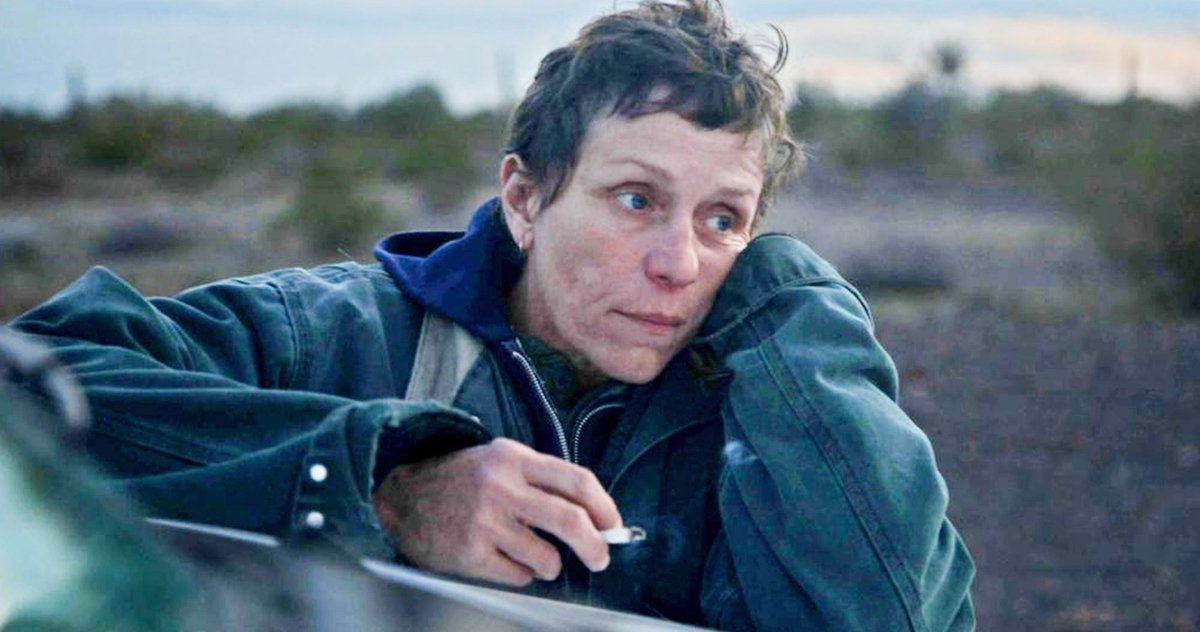“Nomadland” – “I need work. I like work.” – Fern (Frances McDormand)
For years and years, Fern and her husband Bo worked at U.S. Gypsum in Empire, Nev. In business for 88 years at that location, the company manufactured sheetrock, but due to demand shortfalls, U.S. Gypsum closed the Empire plant in 2011. Since the corporation dominated employment opportunities in this tiny, western municipality (that sits about 100 miles north of Reno and 40 miles southwest of Black Rock City), it instantly became a ghost town. In fact, these days – or at least in writer/director Chloe Zhao’s “Nomadland” – Empire seems like one of those frightening places where the U.S. Government built temporary housing communities during the 1950s, filled the dwellings with mannequins, and then dropped nuclear bombs on them to examine the radioactive carnage.
In other words, Fern didn’t have much reason to stay…to stay settled. She no longer had a home, and since Bo passed away, she found herself unaccompanied, jobless, and town-less. Thankfully, our protagonist is not vehicle-less. She refurbished her van, and her wheels became her domicile. Now, Fern lives on the road, and as the audience will discover, like so many others.
Zhao’s haunting, heartbreaking picture not only features McDormand, one of the most recognizable faces in movies, but also several, if not hundreds, of real-life nomads. These ordinary Americans have become existing ones, roaming from remote locale to locale, temporarily settling in one spot until the seasonal work ends. RV parks, 14-foot vans, and plastic buckets (that double as toilets) are commonplace with the Have-nots, as opposed to the sprawling 4,000-square-foot McMansions in the coddled Atlanta, Dallas, or name-your-nearest-city suburbs of the Haves.
Fern’s story is a brutal American one. In the Greatest Country in the World, the social safety net looks like frayed wedges of tissue paper. Men and women work their entire lives to earn about 500 dollars a month in retirement. They spend their golden years battling dental problems and cancer while picking up trash and hauling crates of potatoes on massive farms.
Frankly and admittedly, it took two screenings of “Nomadland” before Zhao’s and McDormand’s sincere cinematic light illuminated this critic’s brain. The narrative feels – or better yet felt – directionless and scattered, which reflects Fern’s existence. She’s just looking to survive, so Fern frequently moves with the feeble economic trickles by laboring at an Amazon sorting facility, passing out coffee at a campground, or simply preparing her next meal. Lots of food and drink prep finds its way on-screen, actually.
The film captures plenty of de minimus moments, the day-to-day ones that usually aren’t worth mentioning. Ordinary, happenings at your house, like unloading the dishwasher or closing the front door, don’t deserve a second look, but for Fern or her friends David (David Strathairn) and Linda May, these particular home-dwelling movements are non-existent or unfathomable luxuries.
Meanwhile, Fern regularly burns calories and precious minutes to find secure spots – in limited spaces – for her small possessions. She searches for laundromats, trades for an adequate can opener, and of course, looks for close by or faraway manual jobs. Zhao uncovers these daily moments, along with quieter ones, like Fern sitting on a lawn chair and staring at the great outdoors or resting on a bench inside a sporting goods store with heat pumping through the air ducts and her shoes relaxing on solid concrete.
She certainly needs some peace because her head swirls with stress over financial hardship, emotional losses, and instability. The constant angst has aged our heroine by at least a decade, as premature wrinkles have become entrenched cracks across her face. Frequent drags on endless supplies of cigarettes are Fern’s only extravagance.
Zhao offers this existence as a tiring, eye-opening foundation over 108 minutes. Along the way, she gently stops and listens to individual tales of woe and coping mechanisms to push through the hardships. One includes a 74-year-old woman’s warm recollection of swallow nests proudly clinging to a Colorado cliff. She recounts that the little birds flew in all directions, and their broken eggshells – their former homes – dotted the river. When cancer only gives someone a few months to live, unspoiled memories may rush to the surface.
Zhao tells Fern’s story and subtly weaves it into the fabric of daily economic toil and vast, grayish landscapes of the American West and Midwest that reflect her life. On so many cinematic occasions, Zhao points her camera at Fern – standing or sitting – alone, either collecting her thoughts, reflecting on her marriage, or just admiring the rocky scenery, like the South Dakota Badlands.
Among certain “Nomadland” Best Picture, Director, and Actress Oscar nominations, Joshua James Richards is a shoo-in for a Cinematography nod too. With almost a yin and yang ecological quality, the cold ground beneath our feet sits under bright open skies and glorious sunsets. There may be some hope for Fern here, but today – either out of fear, circumstance, embedded habits, pure choice, or some combination of all – she’s chosen this life, and her isolation has become her co-pilot. “Nomadland” feels like a western, but here, a villain in a black hat doesn’t stare down our heroine. Her adversaries are two invisible ones: internal restlessness and the external 21st-century American economy.
⭐⭐⭐ 1/2 out of ⭐⭐⭐⭐
Image and Trailer credits: Searchlight Pictures




